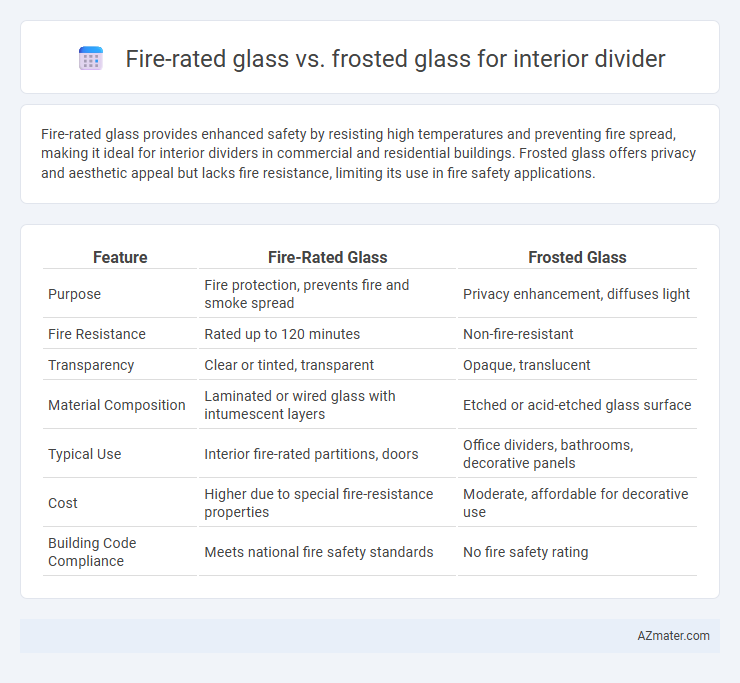Fire-rated glass provides enhanced safety by resisting high temperatures and preventing fire spread, making it ideal for interior dividers in commercial and residential buildings. Frosted glass offers privacy and aesthetic appeal but lacks fire resistance, limiting its use in fire safety applications.
Table of Comparison
| Feature | Fire-Rated Glass | Frosted Glass |
|---|---|---|
| Purpose | Fire protection, prevents fire and smoke spread | Privacy enhancement, diffuses light |
| Fire Resistance | Rated up to 120 minutes | Non-fire-resistant |
| Transparency | Clear or tinted, transparent | Opaque, translucent |
| Material Composition | Laminated or wired glass with intumescent layers | Etched or acid-etched glass surface |
| Typical Use | Interior fire-rated partitions, doors | Office dividers, bathrooms, decorative panels |
| Cost | Higher due to special fire-resistance properties | Moderate, affordable for decorative use |
| Building Code Compliance | Meets national fire safety standards | No fire safety rating |
Understanding Fire-Rated Glass: Key Features
Fire-rated glass offers critical safety benefits by providing resistance to high temperatures and containing flames, often rated to withstand fire for 20 to 90 minutes according to standards like UL 9 or BS 476. This glass is designed with specialized interlayers or coatings that maintain integrity under heat, ensuring compartmentalization in commercial or residential interiors. In contrast, frosted glass prioritizes aesthetics and privacy through surface treatment but lacks any fire protection capabilities.
What Is Frosted Glass? Main Characteristics
Frosted glass is a type of glass surface treatment that diffuses light and obscures visibility, making it ideal for privacy in interior dividers while still allowing natural light to pass through. Its main characteristics include a matte or opaque finish created by sandblasting or acid etching, resistance to fingerprints and smudges, and aesthetic versatility with options for custom patterns or designs. Unlike fire-rated glass, frosted glass does not provide fire resistance or enhanced safety properties but excels in creating visually appealing privacy partitions in offices, bathrooms, and conference rooms.
Fire Safety Benefits of Fire-Rated Glass
Fire-rated glass offers superior fire protection by withstanding extreme heat and preventing the spread of flames and smoke for up to 120 minutes, making it ideal for interior dividers in commercial and residential buildings. Unlike frosted glass, which is primarily decorative and provides no fire resistance, fire-rated glass complies with stringent safety standards such as UL 9 and EN 1364-1. Utilizing fire-rated glass enhances building safety by maintaining visibility and natural light while ensuring critical fire containment and safe evacuation routes.
Privacy Solutions with Frosted Glass
Frosted glass provides effective privacy solutions for interior dividers by obscuring visibility while allowing natural light to pass through, making it ideal for office partitions and meeting rooms. Fire-rated glass, designed to withstand high temperatures and prevent the spread of fire, offers safety benefits but typically has less opacity, which may compromise privacy. Choosing frosted glass enhances confidentiality and aesthetic appeal in interior spaces without sacrificing light transmission.
Aesthetic Comparison: Fire-Rated vs Frosted Glass
Fire-rated glass offers a clear, minimalist aesthetic that maintains transparency while providing essential safety features, making it ideal for modern, sleek interiors where visibility is crucial. Frosted glass, with its diffused, opaque finish, creates a softer, more private ambiance, enhancing intimacy and reducing glare without compromising light flow. Choosing between the two depends on balancing safety requirements with the desired level of visual privacy and design style in interior dividers.
Durability and Maintenance Considerations
Fire-rated glass offers superior durability with its ability to withstand high temperatures and prevent fire spread, making it a safer choice for interior dividers in commercial and residential settings. Maintenance of fire-rated glass involves regular inspections for cracks or damage to ensure its integrity and compliance with safety standards, requiring professional servicing when necessary. Frosted glass, while aesthetically pleasing and offering privacy, is less resistant to impact and heat, needs routine cleaning to prevent surface scratching, and generally demands less specialized maintenance compared to fire-rated glass.
Sound Insulation: Which Glass Performs Better?
Fire-rated glass provides superior sound insulation compared to frosted glass due to its multi-layered construction and specialized materials that block noise effectively. Frosted glass primarily enhances privacy through surface treatment but offers minimal soundproofing benefits. For interior dividers requiring optimal acoustic performance alongside safety, fire-rated glass is the preferred choice.
Cost Differences: Fire-Rated Glass vs Frosted Glass
Fire-rated glass typically costs significantly more than frosted glass due to its specialized materials and fire-resistant properties that comply with safety regulations. Frosted glass is generally more affordable, serving primarily aesthetic and privacy functions without the added expense of fire certification and enhanced durability. Budget considerations often favor frosted glass for standard interior dividers, while fire-rated glass is chosen for areas requiring strict fire safety compliance despite higher upfront costs.
Ideal Applications for Each Glass Type
Fire-rated glass is ideal for interior dividers in commercial buildings, hospitals, and schools where compliance with fire safety regulations is critical, offering both visibility and protection against fire spread. Frosted glass suits office partitions, conference rooms, and residential spaces where privacy and light diffusion are essential without blocking natural light. Choosing fire-rated glass enhances safety in high-risk areas, while frosted glass prioritizes aesthetics and confidentiality in low-risk zones.
Choosing the Right Glass Divider for Your Interior Space
Fire-rated glass offers superior safety by withstanding high temperatures and preventing fire spread, making it ideal for interior dividers in commercial and high-risk areas. Frosted glass enhances privacy and aesthetic appeal by diffusing light and obscuring visibility, suitable for offices or residential spaces where style and discretion are priorities. Selecting the right glass divider depends on balancing safety requirements with design preferences to ensure both function and ambiance are optimized.

Infographic: Fire-rated glass vs Frosted glass for Interior divider
 azmater.com
azmater.com